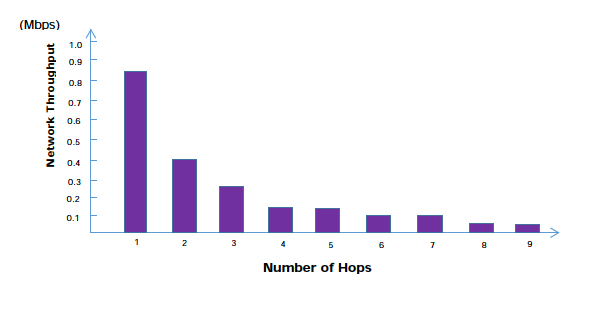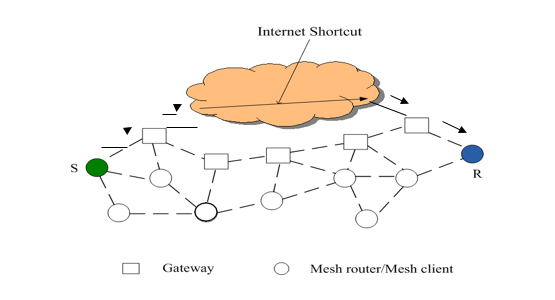
Many regard wireless mesh networking as a potential key technology to provide low-cost Internet over a specific coverage area.
A wireless mesh network (WMN) consists of mesh gateways, mesh routers, and mesh clients. Mesh gateways and mesh routers have fixed power supplies and minimal mobility. Via wireless channels, they form a multi-hop mesh topology, offering backbone connectivity to end user devices.
The One Laptop per Child initiative, which enables students in low-income economies to access content and media, is just one of many early examples of the capacity and uses of the technology.
Wireless mesh networking offers some nice advantages compared to its competitors.
- Resilient communications — mesh topologies are rich in connections. Resilience not only resides in the fact that multiple available paths exist between communication nodes but also the self-healing ability to automatically seek the fastest and most reliable alternative routes if part of the network goes down.
- Low financial cost — mesh gateways and mesh routers are affordable devices. The operational cost of these devices and mesh topology is also low, which benefits business cases with high volume.
- Flexible scale — WMNs can easily scale up to provide connections to users across a wider area. This is achieved by simply attaching more mesh gateways or mesh routers to the mesh backbone.
Even though the technology is still in its early stages, there has been a lot of research into WMNs, particularly looking at how well mesh networking can support long-distance wireless communication. We, a collaborative of five university researchers across three continents, are also interested in answering this question for the purpose of using the technology as a low-cost medium for multimedia multicasting applications.
This blog post discusses a potentially more effective way to address the ongoing challenge of performance degradation over multiple wireless hops that our team has contributed to this ongoing field of research.
WMN performance degrades over multi-hop transmissions
Although a wireless mesh network is physically extensible, we carried out simulation studies to understand the extent to which transmissions via multiple wireless hops suffer from rapid drops in performance as the number of hops increases.

Figure 1 – Throughput performance over multiple WMN hops in our simulations.
Figure 1 shows that the achievable throughput after two hops decreases to less than half of the achievable throughput after one wireless hop. When data travels eight or nine hops, the achievable throughput drops to less than 10% of the original transmission rate in our simulation studies. This is mainly caused by interference between wireless hops. MAC layer activities, for example sensing, also become more significant when there are multiple hops.
Can a wireless mesh network carry long-distance communications?
Due to the performance degradation over multiple hops, it is difficult for a WMN alone to guarantee high-performance communications over long distances. However, the flexibility and low cost of physically extending a WMN still makes it an attractive basis for solutions providing large-scale wireless coverage. As such, quite a few studies have explored alternative approaches for carrying long-distance communications in WMNs.
Major current strategies in controlling interference over multiple hops include:
- the use of different non-interfering channels at different wireless hops as we only have a limited number of non-interfering channels that can be used simultaneously;
- the scheduling of transmissions via time slots as the additionally achieved capacity is limited; and
- the investigation of technologies that can reduce traffic load and hence control the chances of interference as these technologies normally incur complicated operations.
Our idea was to integrate Internet links to bridge the distance between remote WMN nodes. An example of such integrated communications is shown in the figure below. Instead of relaying data via a number of wireless hops between S and R, the Internet shortcut enables data transmissions to avoid suffering from wireless interference over a long distance.

Figure 2 – An example of using Internet shortcuts to bridge long-distance wireless nodes.
In our paper (Resource-Aware Video Multicasting via Access Gateways in Wireless Mesh Networks), the idea is developed with algorithms that form an architecture supporting long-distance wireless multimedia multicasting applications.
The two-tier integrated architecture algorithm chooses communication paths — intra-mesh paths or integrated paths — between nodes by organizing them into a clustered and layered architecture; the weighted gateway uploading algorithm avoids ‘busy’ gateways by uploading video in a manner that balances load and reliability; the link-controlled routing tree algorithm decreases interference from parallel multicasting by constructing a multicast tree with the least number of forwarders in each access area; and the dynamic group management algorithm provides low-overhead maintenance of the multicast forwarding trees when dynamic changes take place.
Our design principles are validated by our extensive simulation results, showing that the multicasting algorithms can achieve up to 40% more throughput than other related published approaches in single multimedia multicasting communications.
This hierarchy architecture is flexible enough to incorporate progressively sophisticated enhancements to each individual algorithmic phase. Moreover, it dynamically changes with the variation of video performance and group membership. It may also appeal to Internet service providers as it uses already established Internet resources to enhance a fundamental issue faced by wireless multi-hop networks.
Wanqing Tu is a Senior Lecturer in the Department of Computer Science at the University of Auckland.
The views expressed by the authors of this blog are their own and do not necessarily reflect the views of APNIC. Please note a Code of Conduct applies to this blog.

A really lightweight article with nothing useful to offer, and then the iEEE paywall to get to the real paper. Your blog needs better technical quality than this.
Hello Stephane,
The post gives an overview of a particular fundamental issue in WMNs and some major current research directions. I didn’t go into the technical details that you wanted to read as I thought that the details would not be interesting for the general audience. For similar reasons I tried to avoid technical jargon as far as possible. I guess that I can offer you the preprint of the journal article if you are interested. If there are specific technical details that you want to know more about, I am happy to develop here.
This article helped me understand the limitations involved with mesh networks as we are trying to use this technology for a machine to machine communication project at work.
Mr. Tu, is it possible to email you some of my questions and start a discussion?
I totally agree with Shashank. Thank you for sharing your knowledge. Just like Shashank, I would like to know whether there is a possibility to get in contact. I also have a few questions.
I’d like to hear from you!
Cheers,
John Divitel
Hello Shashank,
Sure, please send your questions to w.tu@auckland.ac.nz.
Sorry for my late reply – I should check this more often.
Thanks.
Wanqing
Hello John,
Please send your questions to w.tu@auckland.ac.nz
Thanks.
Wanqing